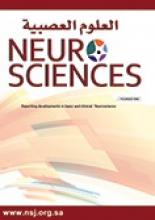Research ArticleOriginal Article
Open Access
The relationship of sleep problems to life quality and depression
Hacı A. Sarıarslan, Yıldırım B. Gulhan, Demet Unalan, Mustafa Basturk and Senol Delibas
Neurosciences Journal July 2015, 20 (3) 236-242; DOI: https://doi.org/10.17712/nsj.2015.3.20150157
Hacı A. Sarıarslan
From the Department of Sleep Medicine (Sarıarslan), and Neurology (Delibas), Kayseri Education and Research Hospital T.R, Ministry of Health, Department of Medical Services and Techniques (Unalan), Erciyes University Halil Bayraktar Health Services Vocational College, Department of Psychiatry (Basturk), Faculty of Medicine, Erciyes University, Kayseri, and the Department of Health Administration (Gulhan), Faculty of Economics and Administrative Sciences, Okan University, Istanbul, Turkey
MScYıldırım B. Gulhan
From the Department of Sleep Medicine (Sarıarslan), and Neurology (Delibas), Kayseri Education and Research Hospital T.R, Ministry of Health, Department of Medical Services and Techniques (Unalan), Erciyes University Halil Bayraktar Health Services Vocational College, Department of Psychiatry (Basturk), Faculty of Medicine, Erciyes University, Kayseri, and the Department of Health Administration (Gulhan), Faculty of Economics and Administrative Sciences, Okan University, Istanbul, Turkey
MDDemet Unalan
From the Department of Sleep Medicine (Sarıarslan), and Neurology (Delibas), Kayseri Education and Research Hospital T.R, Ministry of Health, Department of Medical Services and Techniques (Unalan), Erciyes University Halil Bayraktar Health Services Vocational College, Department of Psychiatry (Basturk), Faculty of Medicine, Erciyes University, Kayseri, and the Department of Health Administration (Gulhan), Faculty of Economics and Administrative Sciences, Okan University, Istanbul, Turkey
PhDMustafa Basturk
From the Department of Sleep Medicine (Sarıarslan), and Neurology (Delibas), Kayseri Education and Research Hospital T.R, Ministry of Health, Department of Medical Services and Techniques (Unalan), Erciyes University Halil Bayraktar Health Services Vocational College, Department of Psychiatry (Basturk), Faculty of Medicine, Erciyes University, Kayseri, and the Department of Health Administration (Gulhan), Faculty of Economics and Administrative Sciences, Okan University, Istanbul, Turkey
MDSenol Delibas
From the Department of Sleep Medicine (Sarıarslan), and Neurology (Delibas), Kayseri Education and Research Hospital T.R, Ministry of Health, Department of Medical Services and Techniques (Unalan), Erciyes University Halil Bayraktar Health Services Vocational College, Department of Psychiatry (Basturk), Faculty of Medicine, Erciyes University, Kayseri, and the Department of Health Administration (Gulhan), Faculty of Economics and Administrative Sciences, Okan University, Istanbul, Turkey
MD
References
- ↵
- American Academy of Sleep Medicine. International classification of sleep disorders
- ↵
- Edinger JD,
- Bonnet MH,
- Bootzin RR,
- Doghramji K,
- Dorsey CM,
- Espie CA,
- et al.
- ↵
- Kaynak H,
- Ardıc S
- Yetkin S,
- Ozgen F
- ↵
- Phillips BA,
- Collop NA,
- Drake C,
- Consens F,
- Vgontzas AN,
- Weaver TE
- ↵
- Katz DA,
- McHorney CA
- ↵
- Ford DE,
- Kamerow DB
- ↵
- Ancoli-Israel S
- ↵
- McCall WV
- ↵
- Pandi-Perumal SR,
- Seils LK,
- Kayumov L,
- Ralph MR,
- Lowe A,
- Moller H,
- et al.
- ↵
- Lee-Chiong,
- Teofilo
- Ohoyan MM,
- Guilleminault C
- ↵
- Stores G
- ↵
- Senthilvel E,
- Auckley D,
- Dasarathy J
- Wallander MA,
- Johansson S,
- Ruigómez A,
- García Rodríguez LA,
- Jones R
- ↵
- Kahraman M
- ↵
- Hilty D,
- Young JS,
- Bourgeois JA,
- Klein S,
- Hardin KA
- ↵
- Chokroverty S
- ↵
- Kirbas D,
- Leonardi M
- Kaynak H,
- Gozukirmizi E,
- Damci d,
- Akıncı T,
- Denktas H
- ↵
- Aslan S,
- Gulcat Z,
- Selda Albayrak F,
- Maral I,
- Yetkin S,
- Sutcigil L,
- et al.
- ↵
- Hisli N
- ↵
- Beck AT,
- Ward CH,
- Mendelson M,
- Mock J,
- Erbaugh J
- ↵
- Buysse DJ,
- Reynolds CF 3rd.,
- Monk TH,
- Berman SR,
- Kupfer DJ
- ↵
- Agargun MY,
- Kara H,
- Anlar O
- ↵
- Eser E,
- Fidaner H,
- Fidaner C,
- Eser SY,
- Elbi H,
- Göker E
- ↵
- Ohayon MM,
- Roth T
- ↵
- Bloom HG,
- Ahmed I,
- Alessi CA,
- Ancoli-Israel S,
- Buysse DJ,
- Kryger MH,
- et al.
- ↵
- Rumble R,
- Morgan K
- ↵
- Fadıloglu C,
- Ilkbay Y,
- Yildirim YK
- ↵
- Senol V,
- Soyuer F,
- Nar Senol P
- ↵
- Saygili S,
- Cil AA,
- Arikan H,
- Dereli E
- ↵
- Luo J,
- Zhu G,
- Zhao Q,
- Guo Q,
- Meng H,
- Hong Z,
- et al.
- ↵
- Gunes Z,
- Korukcu O,
- Ozdemir G
- ↵
- Walsh JK
- ↵
- Perlis ML,
- Giles DE,
- Buysse DJ,
- Tu X,
- Kupfer DJ
- ↵
- Hayashino Y,
- Yamazaki S,
- Takegami M,
- Nakayama T,
- Sokejima S,
- Fukuhara S
- ↵
- Schuiling WJ,
- Rinkel GJ,
- Walchenbach R,
- de Weerd AW
- ↵
- Yildirim A,
- Hacihasanoglu R
- Pyne JM,
- Patterson TL,
- Kaplan RM,
- Ho S,
- Gillin JC,
- Golshan S,
- et al.
- ↵
- Shmuely Y,
- Baumgarten M,
- Rovner B,
- Berlin J
- ↵
- Muluk N,
- Oguzturk O,
- Arikan OK,
- Dikici O
- ↵
- Karabulutlu EY,
- Akyil R,
- Karaman S,
- Karaca M
In this issue
The relationship of sleep problems to life quality and depression
Hacı A. Sarıarslan, Yıldırım B. Gulhan, Demet Unalan, Mustafa Basturk, Senol Delibas
Neurosciences Journal Jul 2015, 20 (3) 236-242; DOI: 10.17712/nsj.2015.3.20150157
Jump to section
Related Articles
- No related articles found.
Cited By...
- No citing articles found.





